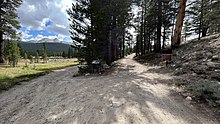Tuolumne Meadows
Tuolumne Meadows | |||||||||||||||||||||||||||||||||||||||||||||||||||||||||||||||||||||||||||||||||||||||||||||||||||||||||||||||||||||||||||||||||||||||||||||
sub-alpine meadow area along the Tuolumne River in the eastern section of Yosemite National Park in the United States. Its approximate location is 37°52.5′N 119°21′W / 37.8750°N 119.350°W. Its approximate elevation is 8,619 feet (2,627 m). The term Tuolumne Meadows is also often used to describe a large portion of the Yosemite high country around the meadows, especially in context of rock climbing.[2][3]
Natural historyThe meadow vegetation is supported by shallow groundwater. The water comes from 1,000 mm (39 inches) of precipitation annually, predominantly in the form of snow. Water arises from snowmelt and hill-slope aquifers, and flows through the Tuolumne River, Budd Creek, Delaney Creek, and Unicorn Creek. In spring, as soon as the snow melts, it is not uncommon to see large areas of the meadows flooded and practically transformed into lakes.[4] While the mountains of the lupin .
Plant dwarf bilberry. Thread-leaved sedge, pussy-toes, Sierra lodgepole pine, and Ross sedge are found in drier uplands within or on the edge of the meadows.[4]
Climate
RecreationTuolumne Meadows has a good view of the Hetch Hetchy Reservoir .
 The road to the meadows is generally free of snow from June through October. Due to the extreme elevation, road access over Tioga Pass along Highway 120 is closed through winter season. Hiking Many backcountry hiking and backpacking trails start in Tuolumne Meadows including the primary route to summit Mono Pass, and Lembert Dome. The day hike trails are popular, and become busy during the summer high seasons. These trails are serviced by the Tuolumne Meadows shuttle bus, typically from June to September, though the dates are subject to change due to weather.[9]
 Rock climbingIn contrast to the big walls of Yosemite Valley, climbing at Tuolumne generally consists of short- to medium-length routes on eleven major domes and a number of minor ones, stretching from the Stately Pleasure Dome above Tenaya Lake to Lembert Dome on the east side of the Meadows. Since the area is all at a high elevation, the climbing season is mainly limited to June through September. The rock is exfoliation, which helps produce and preserve the distinctive dome shapes. The resulting climbing includes both face and crack routes, the former often runout due to limited numbers of bolts, and the latter frequently following very thin cracks. The local ethic is to limit the placement of bolts on new routes and to forbid the addition of bolts to existing routes, resulting in distances of 40 feet (12 m) or more between bolts.[10]
 The major domes include: See Granite Domes of Yosemite National Park for a list of granite domes in Yosemite National park, not just around Tuolumne. In addition, the peaks of the nearby Cathedral Range, such as Cathedral Peak, Pywiack Dome, and Medlicott Dome, are traditionally considered part of the climbing area. InfrastructureThe Tuolumne Meadows area is served by the Tioga Pass Road (California SR 120), which had been paved by the 1920s. Its present route through the meadows was laid out in the 1930s by the Civilian Conservation Corps. A housing area for seasonal employees was relocated at that time, whose new site includes a surviving collection of fine National Park Service rustic CCC-built structures listed on the National Register of Historic Places as "Tuolumne Meadows" in 1978.[11][1]
References
External linksWikimedia Commons has media related to Tuolumne Meadows. | |||||||||||||||||||||||||||||||||||||||||||||||||||||||||||||||||||||||||||||||||||||||||||||||||||||||||||||||||||||||||||||||||||||||||||||
